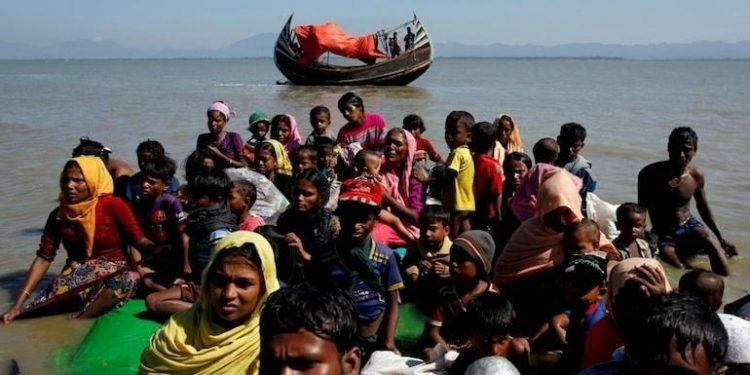It is an irony of history that when the world has responded with alarm, alacrity and legitimate concern to the humanitarian crisis gripping Afghanistan following the Taliban’s return to power, the sufferings of Myanmar nationals persecuted and hounded out by the military junta are not getting the global sympathy they deserve. This is all the more unfortunate since the Tamtadaw – the military rulers of Myanmar – not only staged a coup February 1, but have given tell-tale evidence of their ruthless repression through indiscriminate firings and bombings. The crisis in Myanmar has once again attracted headlines after a few hundred people from the country’s Chin state crossed over to Mizoram in the past few days following airstrikes by the military. This has ominously given rise to fears of another spell of influx of Myanmar nationals into Mizoram which began enrolling some 400 refugee children in schools over a week ago.
The current military offensive in Myanmar is believed to be the fallout of the call for a nationwide uprising given by the country’s National Unity Government in exile. According to reports emanating from Myanmar, the military junta used fighter jets to bomb a village called Lungler near the Mizoram-Myanmar border. The information was shared by Mizoram’s Home Minister Lalchamliana. He expressed fear that more refugees would pour into Mizoram if the airstrikes and other military actions continue. Six districts of the state — Champhai, Siaha, Lawngtlai, Serchhip, Hnahthial and Saitual — share a 510-km long porous border with Myanmar. Official reports suggest about 10,000 refugees have already sought shelter in four of these districts since March. They are lodged in community and public halls and school buildings. Local villagers are providing shelter to the refugees and taking care of their daily needs as the Mizos and Myanmarese people share deep cultural bonds that don’t admit of citizen-refugee divide.
Since Myanmar’s military coup early this year, over a hundred thousand Myanmar nationals have fled the country either to India or Thailand to escape the brutal crackdown by the junta. Among them are politicians, police and military personnel, with the latter two refusing to carry out the junta’s orders to suppress the popular revolt with an iron hand. According to unofficial reports, over 16,000 Myanmar nationals have crossed over to the four Indian border states of Manipur, Mizoram, Nagaland and Arunachal.
The Indian government’s response to the human tragedy unfolding in Myanmar is mired in ambiguity, prevarication and even confrontation with the state government of Mizoram. This is because of multiple factors, including the BJP-led Union government’s narrow politics of bias against the Rohingya Moslems bearing the brunt of the genocide in Myanmar. The situation has become even more complicated with the Mizoram government defying the Centre’s fiat not to give shelter to Myanmar nationals fleeing the country so as not to rub the junta the wrong way. The Centre’s argument is that India can ill afford to antagonise the rulers of Myanmar for security and trade reasons, especially when China wields far greater influence on the running of Myanmar. Incidentally, China has refused to call the military takeover of Myanmar a ‘coup’. That only legitimises the blatant subversion of the democratic process by the junta. Though Myanmar has embraced a sort of hybrid democracy where the military has a big say in the country’s management and governance under a constitutional system, the last election gave an overwhelming mandate to the NLD to rule. But, the junta did not allow the NLD to form its government fearing that the latter might adopt constitutional reforms that would minimise the junta’s role in governance and weaken the huge financial clout that families of the top military rulers enjoy.
India’s reaction to refugee influx falls far short of the need in the absence of a proper legal framework that is followed by most countries in this regard. As per the latest estimates of United Nations High Commissioner for Refugees (UNHCR), India has more than 200,000 legally documented refugees, including Tibetans, Bangladeshis, Chakmas and Tamils from Sri Lanka. In fact, refugees have come to India from all over the world, including Afghanistan, Somalia, Congo, Eritrea, Iran, Iraq, Sudan and Syria.
But, India’s reaction to every refugee situation has always been guided by political considerations and not by any constitutional policy. India is not a signatory to the UN Refugee Convention or the UN Convention on Statelessness. As such, it is not obliged to provide rights laid down in the conventions to refugees. Its decisions on granting long-term visas to refugees are merely ad hoc measures. The legal status of any ‘foreigner’ in the country is governed by two pieces of legislation, the Foreigners Act 1946 and Passports (Entry into India) Act 1920 and the rules issued subsequently under these acts. The absence of a proper legal framework for refugees has led to a situation where India can neither accord wide-ranging benefits to refugees nor get funds from the UN for maintaining refugees.
The exodus from Myanmar once again lays bare the inadequacy of the Indian system and the scope for bias by the government of the day against the hapless people fleeing their native land for their life.







































